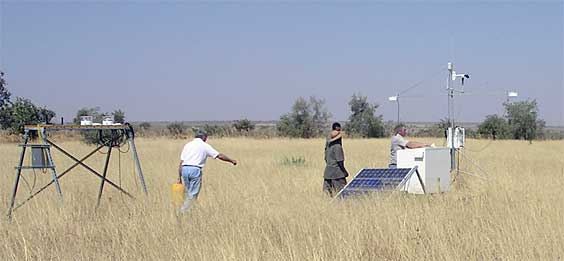ARM Mobile Facility Begins Year-Long Deployment in Africa
Published: 15 January 2006
Beginning on January 9, the ARM Mobile Facility began officially collecting atmospheric data from a location at the airport in Niamey, Niger, Africa. As part of the RADAGAST field campaign, the AMF will measure the effects of absorbing aerosols from desert dust in the dry season, and the effects of deep convective clouds and associated moisture loadings on the transmission of atmospheric radiation during the summer monsoon. These measurements will be combined with associated satellite data to provide the first well-sampled direct estimates of the energy balance across the atmosphere. This dataset will provide valuable information to an ongoing effort called the African Multidisciplinary Monsoon Analysis, or AMMA, in which scientists are studying the interaction between West African monsoon dynamics and scale, continental water cycle, aerosols, atmospheric chemistry, food, water and health. For more information, see the DOE Press Release.

From November 28 to December 2, 2005, ARM scientists involved in the RADAGAST field campaign traveled to Dakar, Senegal, to participate in the AMMA 2005 DAKAR International Conference. They presented various aspects of the AMF deployment to more than 255 attendees from 23 countries. They also discussed the relationship between the AMF and other AMMA observation stations in and near Niamey with regional officials and national meteorological authorities. After the conference, they traveled to Niamey to check on the status and readiness of the AMF at the airport site. They inspected preliminary data streams and recommended some minor site modifications. They then visited the ancillary site about 60 km away, in Banizoumbou, and assisted with instrument systems there.
A recent development in the scientific enhancement to the campaign was the welcome announcement that a scanning C-Band radar, sponsored by the National Aeronautics and Space Administration, will soon be deployed to Niamey. This radar will record the intensity and track the movement of precipitating weather systems within a few hundred kilometers from the AMF during the summer monsoon (rainy) season. Additional data provided by the radar will help in the interpretation of data collected by the various AMF remote sensing systems.
The ARM Climate Research Facility is a DOE Office of Science user facility. The ARM Facility is operated by nine DOE national laboratories, including .
Keep up with the Atmospheric Observer
Updates on ARM news, events, and opportunities delivered to your inbox
ARM User Profile
ARM welcomes users from all institutions and nations. A free ARM user account is needed to access ARM data.


















